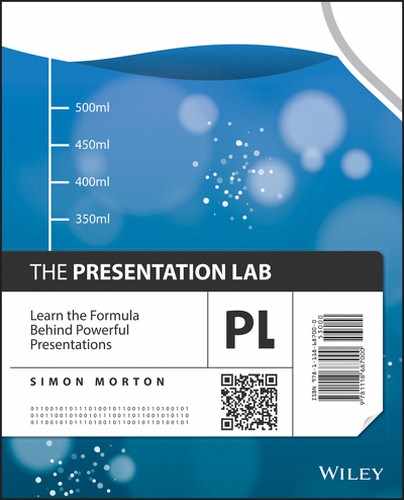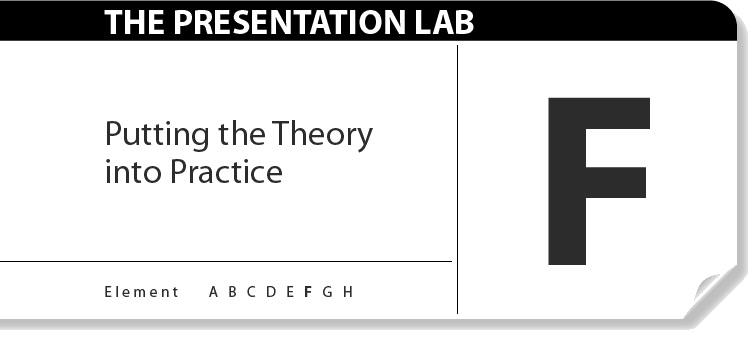The Presentation Optimization process has been developed over many years, and as the result of creating literally thousands of presentations. It works.
However, no matter how carefully we’ve crafted the sections of this book, there’s no getting away from the fact that the real impact of the process only comes to light when you see it working in real life scenarios. So before you get to the real excitement of witnessing this with your own business, you’ll see it play out in this section’s detailed examples.
Each of the following case studies is based on projects that the team at my company, Eyeful Presentations, has worked on. Not only have they been chosen to represent the wide array of presentation formats that business people across the globe use every day, but they also highlight some of the more challenging scenarios in which presenters find themselves. From the “win at all costs” pitch to dealing with the tightrope of sharing bad news within a business, presentations bring with them huge pressure and responsibility. For this reason, we have chosen to make these case studies anonymous. Quite simply, the more we are able to share in terms of backstory and real-life issues, the more value they will bring you and your organization’s next project.
These case studies will demonstrate how the Presentation Optimization process provides a reassuring structure around which to build and sense check your message development as well as your choice of content, visuals, and tools used. No presentation is ever the same, yet each project shares the assurance and confidence that comes from applying a belt and braces approach to their development.
Stepping up in front of an audience, safe in the knowledge that you have a strong and well reasoned story to tell is strangely empowering.
So with this in mind, let’s stop talking about presentations and let’s start sharing some real-life examples.
Case Study 1
The Bid Presentation
Stakes and emotions run high with bid presentations. They typically represent the final hurdle that you and your bid team have to negotiate before a procurement team awards a contract. Prior to this, you will have slaved away for hours preparing a response to their invitation to tender (ITT in procurement speak) and then spent the intervening time wringing your hands and pacing the room. Tensions are high.
The good news is that being asked to present your bid submission means you’re still in the game. The bad news is that the decision that could (possibly) bring you and your business untold riches comes down to how well you and the bid team perform in front of the audience. No pressure, then.
Our client’s immediate reaction was one of horror and disappointment. Horror because losing this contract would mean huge job redundancies across the business (his rough estimate was up to 80 percent of the long-serving workforce) and disappointment because the strong relationship he and his predecessor had developed over many years was apparently worthless.
After a period of blind panic and the collation of vast amounts of information to demonstrate how valuable their products, skills and experience were to the retailer, the CEO reached out to us to work on his PowerPoint slides.
Following a full and frank discussion regarding the situation, we recommended reworking the PowerPoint presentation by employing the Presentation Optimization methodology to bring greater focus to the message and align it directly to this important audience.
Stage 1
Analyzing the audience
The audience was composed of a mixture of disciplines, from the impartial procurement team to the category managers who had built a trusted relationship with our client. Despite their different backgrounds and experience with our client, it became clear very quickly that they shared the same objective: to get the best value for their customers by improving the price points while maintaining their impeccable reputation as a retailer who provided great quality.
As the heat map demonstrates, the factual element of the audience held much, but not all, of the influence in the room. We had to ensure that all present clearly understood the message on cost savings; however, we also needed to address the considerable pull of the Visionary element. Indeed, it was agreed at the workshop stage that creating a hardnosed, cost-saving presentation would have alienated those elements of the audience that wanted to look beyond the new contract’s financial benefits.
Importantly, the CEO felt strongly that the relationship going forward had to reflect the value of trust and innovation that they brought to the table. If it was purely about the money, it was probably not a contract they wanted to win.

Stage 2
Defining the message
Without doubt, this was the most important stage of the entire Presentation Optimization process for this project. There was no lack of information; our client had more than 300 pages of notes, ideas, and reference material. However, for all the passion and enthusiasm, it lacked focus and a simple takeaway message for the audience to grasp.
What followed was an intense workshop session aimed at both filtering this copious information into relevant groups and then directly challenging the concepts being put forward by asking questions like:
- So what if our client had a research and development (R&D) team to develop new products—why was this of value to our audience?
- So what if they had the best customer satisfaction results in their sector—why was this of value to our audience?
- So what if they had won awards for their management of sustainable products—how was this of value to our audience?
(Are you sensing a pattern?)
By challenging the value behind each of our client’s bold claims, we were able to build up a much better picture of how they could play these back to address the retailer’s main concerns: value and quality.
Once these building blocks were in place, we were able to sort them into a simple Need Creation structure using our storyflow process:
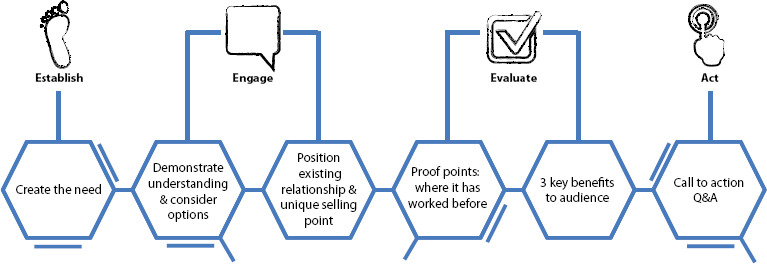
Stage 3
Collating the content
With the structure in place, it was time to filter the content to identify the key points to add to the presentation. By thinking in headline form, we were able to create clear content that locked together to help demonstrate and support the strong overarching message.
At this point, we decided on a two-pronged approach in terms of presentation materials. We would create an extremely visual PowerPoint presentation to frame the general proposition as well as play to the strong Visionary element within the audience. We would then supplement this with a more Factual hard copy document, which we’d refer to at key points within the presentation, demonstrating pricing rationale or projected cost savings.
This enabled us to ensure that all valuable content was available to the audience in a format that was easily accessible when required.
Stage 4
Valuable visuals
Despite our initial fears of him wanting to use the PowerPoint slides as an autocue, the CEO was happy to present using very visual slides. This confidence came from his knowledge of the subject, coupled with access to a strong logical structure to follow and presentation tools that covered both the ‘big picture’ elements as well as the bid detail.
This approach allowed us to play upon the visual subtext behind some of the imagery. Rather than simply showing products in situ, we built upon the retailer’s brand positioning as a store people visit to improve their homes and their family time together. The visuals subtly moved the bid presentation from being purely about unit costs of different product lines into a discussion about how the partnership between both parties would further enhance the retailer’s position in the marketplace.

Stage 5
Delivery
We spent a couple of days supporting and coaching the CEO before the big day. This included ensuring his complete confidence in the presentation story and flow, understanding the importance of pace, and understanding how to use a Blended Presenting approach to get the most out of both the PowerPoint and hard copy presentation.
The outcome
The presentation went like a dream. Our strategies to maximize engagement with the different elements of the audience worked well and quickly took the form of an interactive conversation. This enabled all parties to test their understanding and truly get under the skin of our client’s proposition.
Our client not only retained the existing line of business but also expanded into other areas with the retailer. This safeguarded the jobs of more than 100 people in their manufacturing plant and heralded the start of a new chapter for the business.

Case Study 2
The Conference Presentation
Conference presentations pose a wonderful dilemma to the presenter. Of course, they provide a wonderful opportunity for your story to engage and resonate with a large audience. However, they also put your entire presentation in danger of being hampered by a number of limiting factors out of your control. In the wrong hands or without due preparation, elements such as technology, previous speakers, and your position in the agenda can directly affect your presentation’s effectiveness.
The inevitable profile that comes with speaking at a conference can often be the catalyst for a range of anxieties: Will I lose my train of thought halfway through? Will people simply switch off if I’m not immediately engaging? Should I start with a joke? What happens if I fall over when walking onto the stage? The list of potential conference presentation maladies is almost endless. But without doubt, the biggest source of stress is lack of considered planning and development up front.
The good news is that this is easy to fix.
Our client’s previous conference presentations had been prepared for him by his public relations (PR) agency. In light of the global banking crisis that had been particularly hard felt in the United Kingdom, the topic for this forthcoming event, The Role of the Banking Sector in Turning around the British Economy, was contentious—and proving a difficult one for the PR agency to shape. In frustration, our client’s personal assistant contacted us and asked for assistance.
After a full review of the far-reaching and potentially incendiary topic and the available content, we agreed that a strong story structure was required to navigate through some of the inevitably negative preconceptions within the auditorium.
Stage 1
Analyzing the audience
In light of the tricky relationship between the banks and business following the global financial crisis, a good understanding of the audience profile was absolutely vital in ensuring that our client communicated the message in a way that allowed it to be heard. The audience was made up of financially astute people whose customers, friends, and family had been impacted in some way by the crisis; in many ways, they were looking for someone to blame. As such, the audience heat map was identified as follows:
Ultimately it was important to recognize how normally Factual thinkers in the audience had become incredibly Emotionally charged—and then develop a presentation message that addressed this. It was equally crucial for our client to address the need of the Visionary element of the audience and navigate their way through the detail that had the potential to alienate listeners.
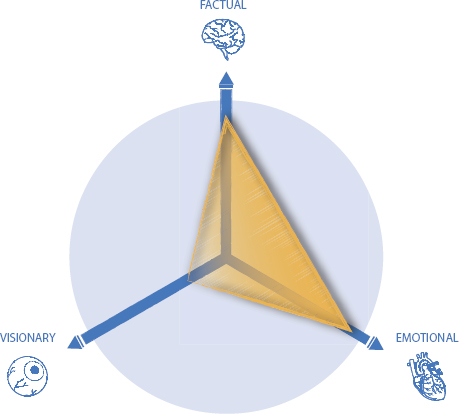
Stage 2
Defining the message
As is often the case with particularly senior contacts, the speaker’s availability was extremely limited. Therefore, the workshop process we normally employed for such a project was simply not logistically possible. We would need to develop the messaging remotely and review it periodically through online meetings.
We commenced by reviewing the vast amount of data the client and PR agency provided. As key categories of information emerged, we ordered and tested them to provide a very high-level story and structure for the client to review.
One strong message emerged through the process. Using the storyflow format as a basis for a series of review discussions, all parties were able to quickly identify with this key message. They could then offer ideas and supporting data to shape how to share it with this profile of audience.
The story structure evolved over time, from a conventional conference approach:
- Tell them what you’re going to tell them
- Tell them
- Tell them what you’ve told them
. . . to a more controlled and structured approach using a “Specific Message Headline” model. We agreed this approach would allow the speaker to address the audience’s specific concerns head-on.
With the key message and story structure identified, it was time to move on to the Content phase.
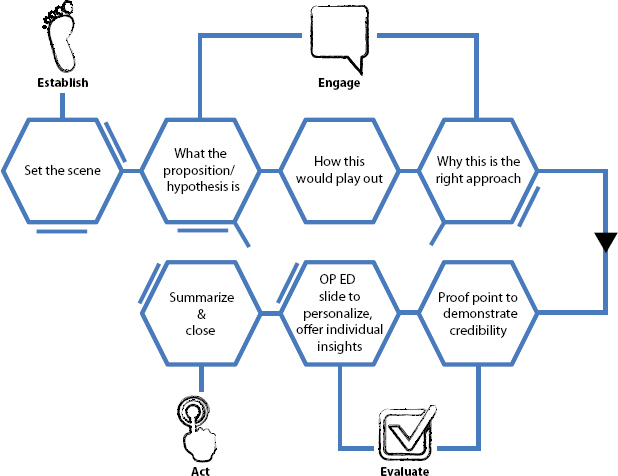
Stage 3
Collating the content
Given the lack of access to the client to run a traditional Presentation Optimization workshop, the message development had started very much in the content detail. As such, the process was one step ahead when it came to agreeing on which elements of the content were important to retain and which ones were left on the cutting room floor.
Previously, the words banking and conference would immediately conjure up images of slides densely populated with charts and data. This analytical approach was always seen as a quick way of establishing credibility, despite the fact that it frequently created a barrier between the audience and the presenter. This project’s strong message—combined with the unusual audience profile—allowed us to think beyond merely quoting a series of statistics. Everyone realized that the content needed to address the strong Emotional charge within the room, so we combined data and statistics with softer anecdotal evidence to support the key message.
Stage 4
Valuable visuals
This different approach opened up a variety of options for the presentation’s visual element. We recognized that the audience would have spent the better part of the day being bombarded with charts and graphs, and attention spans were likely to be suffering as a result.
With this in mind, we introduced elements of animation into the slide deck at key stages. These subtle graphics brought charts to life in line with key points, while more creative animations signposted the move from one section of the presentation to the next. The animations were not designed to distract; however, we recognized that the use of some motion would come as a welcome break to an audience who had been inundated with dry slides all day.
Most important, combining anecdotal evidence with a story-based structure allowed us to use imagery that exploited visual subtext. Powerful images of the banking crisis’ impact—from redundant employees walking out of offices with cardboard boxes full of their desk clutter, to pictures of empty and decaying commercial premises—had a noticeable effect on the audience.
The bank’s acceptance that the crisis had had far-reaching consequences was powerful and disarming. Importantly, it also provided a stage upon which to deliver the presentation’s key message: that the banking community needed to play a key role in rebuilding the economy.

Stage 5
Delivery
The very nature of a large industry conference means that most presenters opt to use slideware like PowerPoint or Keynote, and our client was no different. Although they recognized the value of engaging the audience with other tools such as Prezi or large-scale whiteboarding, they were keen to deliver a presentation in a format that didn’t “rock the boat.”
The stakes were high, and in light of some of the difficulties the client had experienced at previous conferences, they understandably wanted to play it safe. Indeed, such was their concern regarding this event that they also commissioned us to write the complete script, word for word, which would then be delivered to the presenter via autocue.
The outcome
The presentation was well received by the audience and the press who recognized a new level of transparency in the messaging. It also elevated our client’s profile within his own bank, allowing others to see the value of investing time in developing a structured and fully considered presentation from a blank piece of paper rather than simply summarizing vast amounts of data and other content.

Case Study 3
The Sales Presentation
Sales presentations come in all shapes and sizes, from the ubiquitous laptop PowerPoint deck that forms the most important part of a salesperson’s arsenal to newer tablet-based solutions and other visual tools. Whatever the format and whatever the product or service they are designed to help sell, one thing is guaranteed: There are a lot of them!
Of all the presentation forms, the sales presentation is possibly the most hotly debated within a business. The sales force (understandably) sees it as their tool; marketing folks see it as a piece of branded collateral and the product team members are anxious to ensure it has the most up-to-date information in place. Add to that opinion and influence from the legal team and the CEO, and you have the perfect storm. This one of the main reasons most sales presentations fail at delivering their objective; rather than providing a clear and structured argument for buying, they stumble around between braggadocio and confusing the audience with overly complex facts, figures, and product features.
Ultimately, sales presentations need to be led by their intended audience’s needs, not by bickering internal teams. A prospect-focused sales presentation is an incredibly powerful tool in the right hands. If you can get it right, your proposition becomes understandable, engaging and with a strong call to action, in other words, just what the sales doctor ordered.
The sales management had voiced their concerns that their existing presentation was more of a hindrance than a help in most meetings. They felt it did little to build a relationship with the prospect, and it had been created in isolation by the marketing team. As a result, many members of the sales team were either creating their own versions of the presentation or ditching it completely and, in their own words, winging it. Clearly, something had to change.
A quick review of the existing deck made the issues abundantly apparent: It was packed to the rafters with data, statistics, and legal caveats that did little to build need or instill confidence for the prospect. Equally, the very generic slides left the audience feeling that they were on the receiving end of a “canned” presentation. This would be bad enough news for small-value business, but as each of these deals were typically $2.5 to $5 million in value, it was quickly becoming a major issue.
The obvious first move was to pull all the internal customer stakeholders together and run them through a Presentation Optimization process to define a clear and valuable message—and then build content accordingly.
Stage 1
Analyzing the audience
Our customer was fortunate to work with some very high-profile brands’ marketing and financial teams. Without doubt, the audience’s marketing segment had a reputation as thought leaders in their field, both in terms of managing brands and developing customer engagement campaigns. On first impressions, some of them may have come across as aloof; others simply wore the confidence of people who knew they were very good at their job, yet they were also looking for new ideas and inspiration. As a result, there was a high Visionary element within the audience.
However, this Visionary element was countered to a certain extent by a strong Factual pull from the business’s financial elements. Although looking to extend or challenge brand perceptions with innovative campaigns, there was a strong underlying sense that our client had to demonstrate a return on investment (ROI) before budgets were approved.
These two strong elements within a typical audience for our customer led us to identify the heat map as follows:
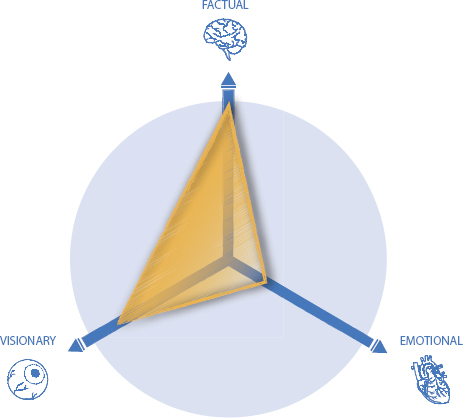
Stage 2
Defining the message
Developing the message was a relatively straightforward process. As is often the case, once all parties started to discuss their understanding of the customer issues, they reached consensus remarkably quickly!
To aid the process, the consultant decided not to aim for one “killer message” and instead look to develop the presentation around three key messages that would resonate across the diverse audience profile. This also allowed the workshop participants to debate the merits of a range of messages rather than fiercely protect their own standpoint.
Perhaps the biggest challenge was the major overhaul to the presentation’s structure. We were looking not only to extend the format beyond simply PowerPoint but to also include hard copy and iPad versions. We dramatically changed the functionality across the slide deck.
By moving away from a standard linear presentation to a more interactive toolkit approach, we had compelled the presenters to engage the audience in a more intimate and conversational style. The new structure allowed them to drill-down to information and examples in response to their customers’ interest rather than working from slide to slide in a lecture style. This not only broke down the barriers but also allowed the presenter to respond to questions in a much more natural but authoritative way.

Stage 3
Collating the content
There was a vast amount of content to wade through. Following the workshop session to develop the message and high level structure, the consultant offered a presentation amnesty to all parties involved. The thinking was simple—there would be small nuggets of gold within the plethora of PowerPoint slides used by different parts of the global team that would support the three key messages.
Most important, the new format and story structure allowed us to challenge the status quo. We were able to lose many of the text-heavy slides and consolidate the detailed content as a leave-behind hard copy deck. Additionally, the new interactive format allowed us to push the company credentials element to the back of the presentation. As a result, the audience was greeted with content that applied to their issues rather than a long list extolling our customer’s virtues and achievements.
Stage 4
Valuable visuals
The project quickly picked up the pace, and many people saw it as an opportunity to ditch the bullet points and embrace a much more visual approach. That said, we took care not to alienate the wide range of presenters who would be using this tool; some had felt comforted by having some text on the slide.
It was also at this stage that we were able to identify how to best visualize the content for each different presentation tool. The hard copy presentation was, by design, always going to be a more comprehensive, data-led form of presentation versus the PowerPoint and iPad versions.
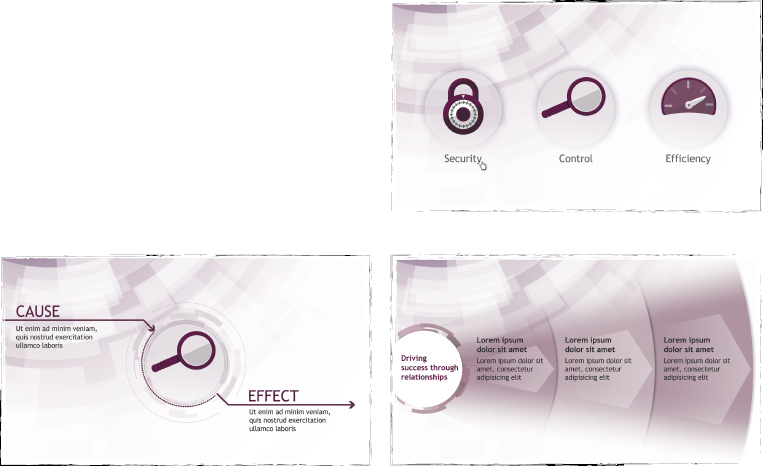
Stage 5
Delivery
Coaching presenters on how to use these new presentation tools to maximum effect was an important part of the roll-out. It helped ensure that they would embrace the new sales tools rather than view them with suspicion. Uptake of the new approach was a key measure of success; we would have failed if the mavericks within the sales team had continued to take their own path in front of prospects.
It was also important that the team personalized each of the presentations before delivering them to a prospect. This went beyond simply adding a company logo to the front slide; it required the sales team to properly research the prospect, adding relevant information within the deck to demonstrate understanding and synergy.
The outcome
It’s fair to say that the new presentation’s very different approach and format took some ‘bedding in’ with a few isolated groups within the sales team. Thankfully, the management team’s support and belief played a crucial part in ensuring that the few remaining rebels were coached into understanding the new approach’s benefits. We were able to support this through a series of online coaching and technical training sessions.
Overall, the new format and tool options have been a huge hit with prospects and presenters. Audiences have commented on the flexibility of the presentation—“We feel like we’re being listened to” while presenters have embraced the flexibility it provides them in front of their prospect.

Case Study 4
The Internal Presentation
Internal communication is a tricky thing to get right.
Frequently, important internal messages get lost in the noise of everyday work life—often, ironically, as a result of the large amounts of internal communication, formal and informal. Countless companywide e-mails, intranet postings, and internal meetings all add to the noise, much of which is either irrelevant to the majority of people or quickly pulled together in an ad hoc way.
The internal presentation is a great example of the good and bad elements within in-company communication. The intention is normally good—”We have some important information that we need to share with our employee team”—possibly related to the company’s financial performance, new strategies or acquisitions. However, for all these good intentions, most internal presentations fail in the key elements: audience engagement, clear and focused messages, relevant content, and engaging visuals. There is often a sense that internal presentations can be a little shabby around the edges because external audiences won’t be viewing the slides. It’s as if its ‘internal presentation’ status gives the presenter license to cut a few corners—when this couldn’t be further from the truth.
In fact, internal presentations are often the most important and influential presentations many of us will ever make. Clear and engaging internal presentations can help turn a failing business around, engage an employee team and celebrate success in the most inclusive way. Failing to invest sufficient time and energy in such a communication is failing to invest in your company and its people. Internal presentations really are that important.
The small internal team responsible for coordinating the communication had wrestled with the best way to share it across the business. They’d considered a number of ideas, including a company-wide videoconference or distribution of a detailed document. They ultimately decided that the Chairman would deliver a presentation to his senior board on the changes. Then the senior team would use this same presentation to disseminate the information within their divisions through a series of face-to-face meetings.
It was at this point that we were called in.
Stage 1
Analyzing the audience
As is often the case with internal presentations about big change, the normal nature of the audience changes quite dramatically when there is a perceived threat to their security. As with every large business, the workforce would normally be made up of a mix of Factual, Emotional, and Visionary profiles. This mix would flex in line with the presentation type, from being on the receiving end of a sales pitch or listening to a company update.
Naturally, a large-scale strategic change was going to push the audience very heavily toward the Emotional behaviors. It was crucial to factor in not just the immediate Emotional response but also the subsequent questions that would come later in the process. A key measure of success was that the audience understood and was engaged with all the information shared—and didn’t go off on an anxiety-fuelled tangent.

Stage 2
Defining the message
The message was so much more than job losses. The strategic changes were about protecting the business, maintaining competitive advantage and addressing new threats. However the post-presentation water cooler conversation topic was doubtlessly going to be about people’s job security. We knew we had to meticulously plan the story’s structure to ensure that all the points were covered and understood.
After much discussion with the Chairman and his team, we recommended keeping the presentation as short and focused as possible. There was no benefit in overloading the audience with too much information; the structure needed to provide the presenters with the opportunity to quickly put the changes in context and then cut to the chase as to what this meant to the people in the audience. We were determined to make this the most audience-centric internal presentation the company had ever delivered.
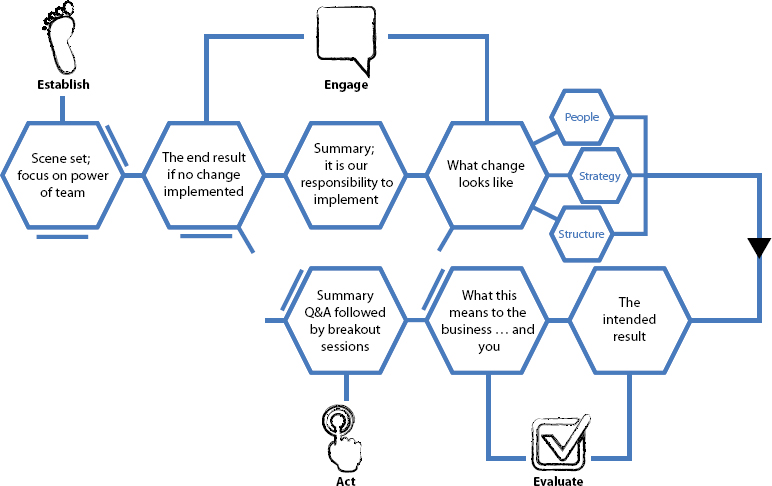
Stage 3
Collating the content
Naturally, a change of this magnitude was based on a vast amount of data and reasoning. No matter how devastating for those impacted by the job losses, the new strategic approach was absolutely necessary to address the coming challenges in the marketplace—and the customer had the content to prove it.
However, we took the view that the inevitable Emotional response from the audience would render much of the available content almost useless. At best, they’d ignore it—and possibly even misconstrue it.
We therefore recommended a Blended presenting approach to the communication. First, share the Executive Summary version of the new strategy (including the contentious elements) with the audiences face to face. This was to be supported with a much more detailed hard copy document, which the speaker would refer to throughout the presentation, highlighting areas for audience members to review post presentation. A series of Q&A sessions were then scheduled to coincide with the introduction of the HR function within each of the divisions.
Stage 4
Valuable visuals
The nature of the material being presented plus the addition of a text heavy hard copy support document meant that we were keen to make the slides as visual as we possibly could. The development of simple visuals to illustrate the changes and their intended impact was designed to enable audience members to engage with the message, despite their attentions probably being elsewhere.
Interestingly, we recognized that the strong Emotional audience profile meant that using images with powerful visual subtext was less important than a typical presentation. The subject matter ensured that they were already emotionally engaged.
The development of visuals for the hard copy presentation was also relatively subdued. The purpose of the document was to share sufficient detail and content to support the main story, and it was designed to make navigation as simple as possible.

Stage 5
Delivery
The presentation was going to be cascaded throughout the business, from the Chairman down through his direct reports and divisional heads. Its sensitive nature, coupled with a wide variety of presenters, prompted a series of coaching sessions run across three different locations.
There is undoubtedly an art to delivering an emotionally charged message using the Blended Presenting method. So we took time to ensure all parties were comfortable and completely prepared before making the announcement.
The outcome
Despite the difficult subject matter, the presentation and communication process was regarded as a success by all involved in the project. The clarity of the message ensured that all affected parties were aware of just how the changes would affect them and the next actions to take. This addressed any potential false information from being spread across and then outside the business (Think of the game telephone.)
The company remains a major player in their sector and has managed to stay strong and relevant through tough economic times.

